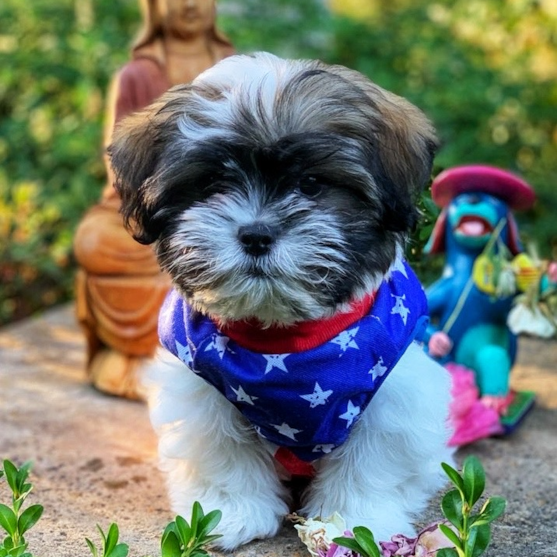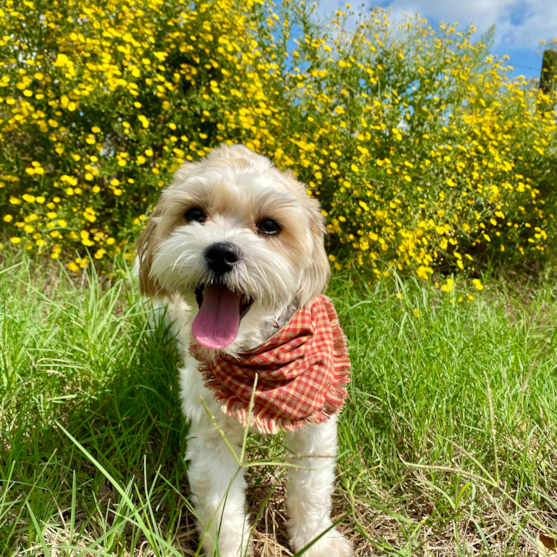Teddy Bear Breed Information


The Shichon and Mal-shi, also known as "teddy bear dogs," are two popular crossbreeds that have become increasingly popular in recent years. These adorable designer breeds are a mix between a Bichon Frise and a Shih Tzu or a Maltese and a Shih Tzu, resulting in a small, fluffy, and affectionate companion that many people adore.
The Shichon, also known as the Zuchon or Teddy Bear, typically weighs between 10-15 pounds and has a soft, curly coat that requires regular grooming. They are known for their playful and friendly temperament, making them a great choice for families with children or seniors looking for a loyal companion.
The Mal-shi, on the other hand, is a slightly smaller breed, weighing in at around 6-10 pounds. They have a straight, silky coat that also requires regular grooming. Mal-shis are known for being gentle and affectionate, making them an ideal choice for apartment living or for individuals who are looking for a lap dog.
Both the Shichon and Mal-shi are loving and devoted pets that make great companions. They are easy to train, enjoy spending time with their families, and have a reputation for being great with children and other pets. If you are looking for a loyal, affectionate, and low-maintenance companion, the Shichon or Mal-shi may be the perfect breed for you.
Characteristics
- Appearance: Teddy Bear dogs have a fluffy and soft coat, often resembling a teddy bear, which is where the breed gets its name. The coat can come in a variety of colors, such as white, black, brown, and gray. The ears are often floppy, and the eyes are round and expressive.
- Hypoallergenic: Both the Shihcon and the Mal-shi have low-shedding coats and produce very little dander, an aspect that makes them good hypoallergenic breeds. They make excellent pets for allergy-suffering owners.
- Size: Teddy Bear dogs are small in size and typically weigh between 6 to 15 pounds and stand about 9 to 12 inches tall at the shoulder. Their compact size makes them ideal for those who live in apartments or smaller homes.
- Temperament: These breeds are known for their friendly and affectionate nature. They love to be around their owners and are great companions for families and individuals alike. They also tend to be good with children and other pets.
- Trainability: Teddy Bear dogs are generally easy to train due to their high intelligence and eagerness to please their owners. Positive reinforcement methods work best with these breeds, and early socialization and training is important.
- Exercise Needs: While they are small in size, Teddy Bear dogs still need regular exercise to maintain good health. Daily walks and playtime are important to keep them physically and mentally stimulated.
- Health: These breeds are generally healthy, but like all dogs, they may be prone to certain health issues such as dental problems, allergies, and respiratory issues. Regular vet checkups and good dental hygiene are important to keep them healthy.
- Lifespan: The average lifespan of a Teddy Bear dog is around 12 to 16 years, which is longer than many other small breeds. With proper care and attention, these dogs can provide many years of love and companionship to their owners.

Appearance
The Teddy Bear dog breed is known for its cute and cuddly appearance, which has made it a popular choice for pet owners around the world. These dogs typically have a soft and fluffy coat, which can come in a variety of colors such as white, black, brown, and gray.
One of the unique features of the Teddy Bear breed is their teddy bear-like appearance, which has made them instantly recognizable. They have a round head and a short muzzle, with expressive eyes that are often dark and round. Their ears are usually floppy and hang down, and their small, compact body gives them an adorable and huggable look.
Teddy Bear dogs are small and typically weigh between 6 to 15 pounds and stand about 9 to 12 inches tall at the shoulder. Their size makes them a great choice for people who live in apartments or smaller homes.
Another distinguishing feature of the Teddy Bear breed is their low-shedding coat. They have a hypoallergenic coat, which makes them an ideal choice for people who have allergies or who don't want to deal with excessive grooming. However, their coat does require regular brushing and occasional trimming to keep it looking neat and tidy.
It's important to note that the appearance of Teddy Bear dogs can vary depending on their specific breed and their individual genetics. Some may have a curlier or wavier coat, while others may have more straight hair. The color of their coat may also vary, with some dogs having a solid color coat and others having a combination of two or more colors.
Photos
Temperament
Teddy Bear dogs are known for their friendly and affectionate temperament, making them a great choice for families and individuals who want a loving companion. They are also intelligent, social, and eager to please, which makes them relatively easy to train.
One of the defining characteristics of the Teddy Bear dog breed is their desire to be close to their owners. They love to cuddle and are often referred to as "lap dogs." Their friendly and outgoing nature also makes them great with children and other pets, though as with all dogs, proper socialization is important.
Teddy Bear dogs are also known for their playful and energetic personalities. They enjoy playtime and thrive on attention from their owners. While they don't require a lot of exercise, daily walks and indoor playtime are important to keep them healthy and happy.
Despite their affectionate nature, Teddy Bear dogs can be prone to separation anxiety if left alone for long periods of time. They do best with owners who are home often or who can provide them with plenty of attention and stimulation.
Care
Grooming
The Teddy Bear dog breed has a luxurious, hypoallergenic coat that requires regular grooming to keep it looking healthy and tidy. Their coat is soft and fluffy, with a thick, curly or wavy texture that is pleasant to the touch.
Teddy Bear dogs require regular brushing to prevent matting and tangling of their hair. A slicker brush is recommended for this breed, as it can easily remove loose hair and prevent matting. The frequency of brushing will depend on the length and thickness of their coat, but daily brushing is recommended to keep their coat in good condition.
Their coat will also need occasional trimming to maintain its shape and prevent matting, particularly around the eyes, ears, and paws. It is important to use proper grooming tools and techniques to avoid cutting their skin or causing discomfort.
Teddy Bear dogs also require regular bathing, but it is important not to over-bathe them, as this can strip their coat of its natural oils and cause dry skin. Bathing once a month, or when they get dirty, is generally sufficient for this breed.
In addition to regular brushing and bathing, Teddy Bear dogs also require regular dental care, nail trimming, and ear cleaning to keep them healthy and comfortable.
Exercise Needs
The Teddy Bear dog breed is a small and low-energy breed, which makes them well-suited for apartment living and individuals with busy lifestyles. They do not require a lot of exercise, but it is still important to provide them with regular physical activity to maintain their health and happiness.
Teddy Bear dogs benefit from daily walks, which can provide them with mental stimulation and an opportunity to explore their surroundings. A 15 to 30-minute walk once or twice a day can be sufficient for most Teddy Bear dogs, but the specific exercise needs of each individual dog may vary based on their age, health, and temperament.
In addition to walks, indoor playtime can also provide Teddy Bear dogs with much-needed exercise and mental stimulation. Games such as fetch, tug-of-war, and hide-and-seek can be fun for both the dog and their owner. Puzzle toys and treat-dispensing toys can also provide a mental challenge, which can help keep these intelligent dogs engaged and entertained.
It's important to note that while Teddy Bear dogs do not require a lot of exercise, they can still be prone to weight gain if they are not provided with enough physical activity. Obesity can lead to a variety of health issues, including joint problems, diabetes, and heart disease. It's important to monitor their diet and provide them with regular exercise to maintain a healthy weight.
Health
The Teddy Bear dog breed is generally a healthy breed with a long lifespan. However, like all breeds, they are prone to certain health issues that potential owners should be aware of.
One common health issue in Teddy Bear dogs is dental problems. Due to their small size, their teeth can become overcrowded, which can lead to dental decay and gum disease. Regular dental check-ups and daily tooth brushing can help prevent these issues and maintain their oral health.
Another common health issue in Teddy Bear dogs is allergies. They may be prone to skin allergies, which can cause itchiness, redness, and discomfort. Owners should monitor their dog's skin and consult with a veterinarian if they notice any signs of skin irritation.
It's important to note that proper diet, exercise, and regular veterinary check-ups can help prevent and manage many of these health issues. It's also important to obtain a Teddy Bear dog from a reputable breeder who performs health screenings on their breeding stock.
Lifespan
The Teddy Bear dog breed has a relatively long lifespan, with an average lifespan of 12 to 16 years. However, their lifespan can vary based on a number of factors, including genetics, diet, exercise, and overall health.
Teddy Bear dogs that are properly cared for and given a healthy diet and regular exercise can live longer and healthier lives. Regular veterinary check-ups can also help detect and manage any health issues that may arise, which can help increase their lifespan.
It's important to note that some health issues can impact the lifespan of Teddy Bear dogs. Dental problems, allergies, and joint issues, such as luxating patella, can all have an impact on their lifespan. Regular dental check-ups, proper diet, and regular exercise can help prevent or manage these issues and help increase their lifespan.
Training
Teddy Bear dogs are intelligent and eager to please, which makes them relatively easy to train. Positive reinforcement methods, such as praise and treats, are recommended for training these dogs.
Crate training is also recommended for Teddy Bear dogs, as it can help with house training and provide them with a safe and comfortable space to retreat to when needed.
Socialization is another important aspect of training for Teddy Bear dogs. They should be exposed to a variety of people, animals, and environments from a young age to help prevent fear and aggression towards new situations.
In addition to obedience training and socialization, mental stimulation is also important for Teddy Bear dogs. Puzzle toys, interactive toys, and games that challenge their mind can help prevent boredom and destructive behavior.
It's important to note that Teddy Bear dogs can be sensitive to harsh training methods and may become fearful or anxious if treated roughly. Positive reinforcement methods, such as praise and treats, are recommended to build trust and establish good behavior.
History
The Shichon and Mal-shi breeds are relatively new, having only been developed in the last few decades. Both breeds were created by crossing two small companion breeds, the Shih Tzu and the Bichon Frise for the Shichon, and the Maltese and the Shih Tzu for the Mal-shi.
The goal in creating these breeds was to produce a small dog with a friendly and affectionate personality, a hypoallergenic coat, and a teddy bear-like appearance. Both breeds have become increasingly popular in recent years due to their cute looks and loving personalities.
The Shichon was first developed in the United States in the 1990s, where breeders began crossing Shih Tzus and Bichon Frises to produce a new breed. The exact origins of the Mal-shi are unclear, but it is believed to have been developed in Australia in the 1990s.
Both breeds were created with the intention of producing a dog that would be a great companion for families and individuals. They are known for their friendly and affectionate personalities, and their small size and low-shedding coats make them ideal pets for people who live in apartments or smaller homes.












